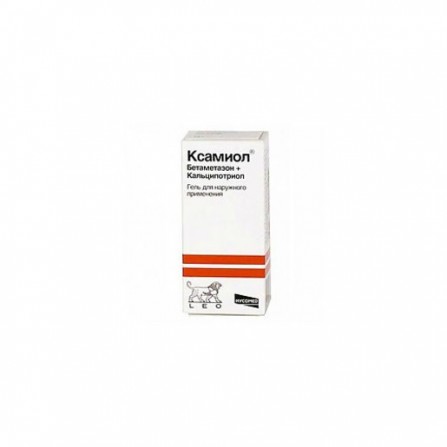Xamiol gel for external use 60g
Condition: New product
1000 Items
Rating:
Be the first to write a review!

More info
Description
Gel for external use Xamiol is based on the hormones glucocorticosteroids and vitamin D. It has anti-inflammatory effect and significantly improves the appearance of the skin. Reduces the intensity of the pathological reproduction of cells in areas of skin lesions with psoriasis and reduces inflammation.
Active ingredients
Betamethasone + Calcipotriol
Release form
Gel
Composition
Betamethasone, calcipotriol, liquid paraffin, PPG-15, castor oil.
Pharmacological effect
Calcipotriol is a synthetic analogue of the active metabolite of vitamin D. It causes inhibition of keratinocyte proliferation and accelerates their morphological differentiation. Betamethasone, a glucocorticosteroid (GCS) for external use, has a local anti-inflammatory, antipruritic, vasoconstrictive and immunosuppressive effect, but the exact mechanisms of the anti-inflammatory effect of steroids for external use are not completely clear. The use of occlusive dressings enhances the effect of corticosteroids, as this increases their penetration into the skin.
Pharmacokinetics
When using the drug, the absorption of calcipotriol and betamethasone through intact skin is less than 1%. When applying the drug to psoriatic plaques and under occlusive dressings, the absorption of external GCS increases. Since a depot preparation is created in the skin, it is eliminated from the skin within a few days. Betamethasone is metabolized in the liver and in the kidney to form glucuronides and sulfoesters, excreted through the intestines and kidneys.
Indications
Psoriasis of the scalp. Psoriasis is mild to moderate in other parts of the body.
Contraindications
Diseases involving a violation of calcium metabolism. Hypersensitivity to any of the components of the drug. Severe renal and hepatic failure. Viral (herpes, shingles), fungal, bacterial and parasitic infections of the skin, rosacea, rosacea, common acne, perioral dermatitis, skin manifestations of tuberculosis and syphilis, skin atrophy, ulcers, wounds, itching in the perianal region and in the genitalia, fragility of skin vessels, ichthyosis, striae. Psoriatic erythroderma, drop-shaped, exfoliative, pustular psoriasis.Age up to 18 years.
Use during pregnancy and lactation
Use only if the intended benefit to the mother outweighs the potential risk to the fetus. If necessary, the use of the drug during lactation is recommended to refuse breastfeeding.
Dosage and administration
Outwardly. The gel is applied with a thin layer to the affected areas of the scalp or psoriatic plaques of other parts of the body 1 time per day.
Side effects
Itching, rash, burning sensation, pain, irritation, dermatitis, exacerbation of psoriasis, folliculitis, dry skin, acne, pustular psoriasis.
Overdose
Symptoms: an increase in calcium in the blood, with the termination of the use of the drug is quickly restored, the suppression of the function of the pituitary-adrenal system with the development of reversible secondary adrenal insufficiency. Treatment: cancel the drug and conduct symptomatic therapy. In cases of chronic toxicity, GCS should be phased out.
special instructions
Do not use the drug on mucous membranes. Use with caution when applied to the skin of the face and genitals. In case of accidental eye contact, unwanted adverse reactions are possible in the form of eye and skin irritation, conjunctivitis. In case of accidental contact with eyes, rinse with running water. After applying the drug you need to wash your hands. With the development of secondary infections, antimicrobial therapy should be prescribed. Termination of psoriasis treatment by local corticosteroids with drugs may be associated with the risk of developing generalized pustular psoriasis and the effect of withdrawal. Therefore, after discontinuation of such treatment, it is necessary to continue clinical observation of the patient. During the treatment period, the patient is advised to limit or avoid excessive exposure to natural or artificial sunlight. Calcipotriol (and preparations containing it) are allowed to be applied topically in combination with ultraviolet radiation only in cases where the attending physician considers the risk of undesirable side effects associated with such treatment justified.


